R&D Information
Pick Up Contents
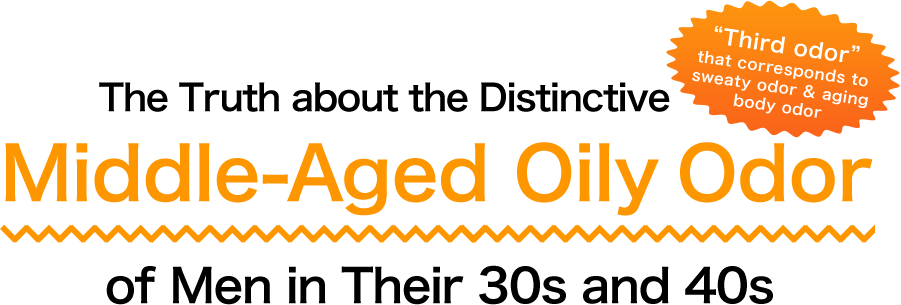











What is "middle-aged oily odor"?
Through its unique research regarding men's body odor, Mandom has discovered a "third odor" distinctive to men in their 30s and 40s. This odor is different from sweaty odor and aging body odor.
We call it "middle-aged oily odor."
"Diacetyl" included in sweat is a key compound for middle-aged oily odor, which smells like old, used oil and is mainly generated from the back and crown of the head. Although men have difficulty noticing this odor themselves, women notice it easily as it has the characteristic of being unpleasant.
An everyday scenario inspired
a researcher
to begin research
on a new odor.

One day, a Mandom researcher was playing futsal as a group activity. When he was in the gym and locker room with men in their 60s, he noticed the peculiar smell of "2-nonenal," the compound that causes aging body odor.
However, when he was in the same gym and locker room with men in their 30s and 40s, he noticed that although the smell of "2-nonenal" was almost completely nonexistent, there was another different unique odor.
Ultimately, this researcher thought to himself, "I wonder if there is a compound causing an odor different from 2-nonenal…"
And in this manner an everyday scenario led to this kind of hypothesis, and research that searched for "the compound of the peculiar odor produced by men in their 30s and 40s" began.
Men's Body Odor Starts to Change
Around the Age of 30-40
Age of men who start to notice
change in body odor due to increasing age
Half of consumers in their 30s and 40s notice that
men's body odor changes with increasing age.
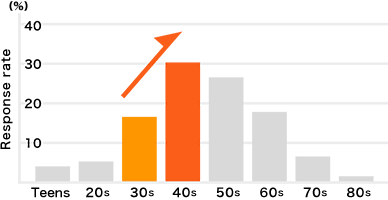

Awareness survey regarding men's body odor
- Survey Subjects
- 1,200 Japanese men teens to 60s
- Survey Period
- July 2008
- Survey Method
- Internet questionnaire survey
We know from past studies that aging body odor generally starts being produced at full tilt from the age of 50 and above.
However, we now know that many consumers in their 30s and 40s realize that their body odor changes as they age.
Out of all the age ranges, we found that men in their 40s were the ones who noticed changes in their body odor the best. Combine that data with the results for men in their 30s, and that number jumps to roughly half of all survey subjects.
For consumers themselves, there was also a gap between the decade when aging body odor was produced and the decade when subjects realized a change in their body odor.
How was middle-aged oily odor
discovered?

Pinpointing the region producing the odor
Around 800 test subjects throughout a 7-year period!
Researchers performed measurements by directly smelling with their noses
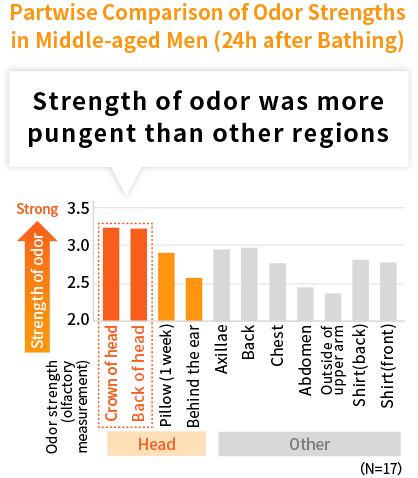
Mandom researchers performed measurements by using their noses to first directly smell various regions around the bodies of men in their 40s and 50s such as the axillae, head, feet, and trunk.
As a result, the researchers found that the odor produced from the head of men in their 40s and 50s was the strongest, and that the odor produced from the region behind the ears (which was said to be the source of aging body odor) was the weaker. (Figure 1)
Determined that
head was the source
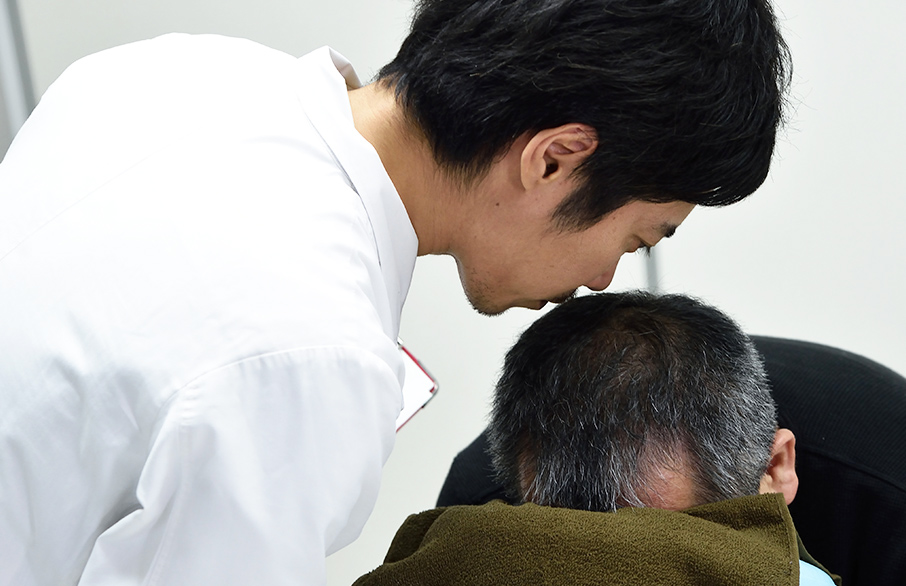

After checking the smell of pillows…
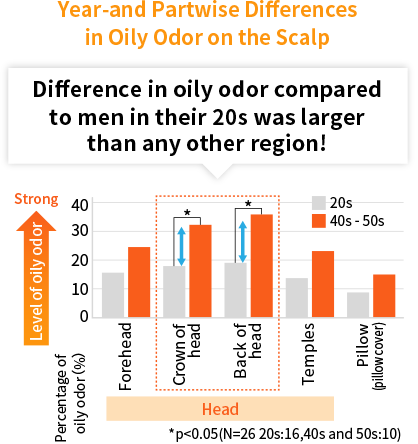
We also decided to evaluate the smell of pillows since the odor produced from the head was strong.
In order to collect odors from pillows, we placed covers on pillows and had our test subjects actually sleep on them for a certain period of time.
Then, after comparing the characteristics and qualities of odors produced from the heads of male test subjects in their 40s and 50s with those of men in their 20s, we found that the heads and pillows of men in their 40s and 50s produced a stronger oily-smelling odor than men in their 20s did. (Figure 2)
Oily-smelling odor on pillow...
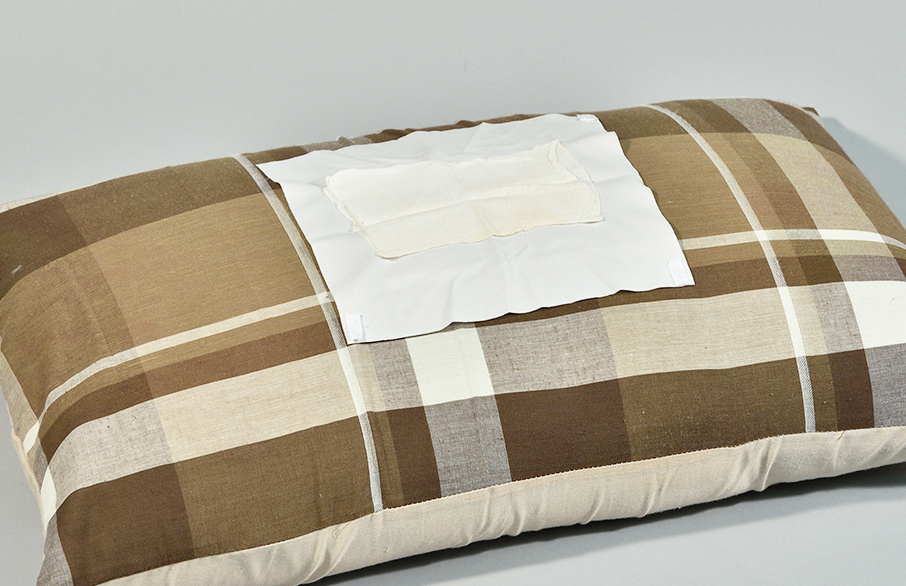

The name "middle-aged oily odor"
comes from this unique
oily-smelling odor

Identifying the odor's true identity
Collecting head odor samples
Next, we gathered and analyzed odors in order to identify its true identity.
Sampling bags were placed on test subjects' heads, and the odors being produced were captured within the bags.
The sampling bags were made of special materials that made it difficult for odor molecules to adhere to, and special gas cylinders were used to gather the odors from the bags.
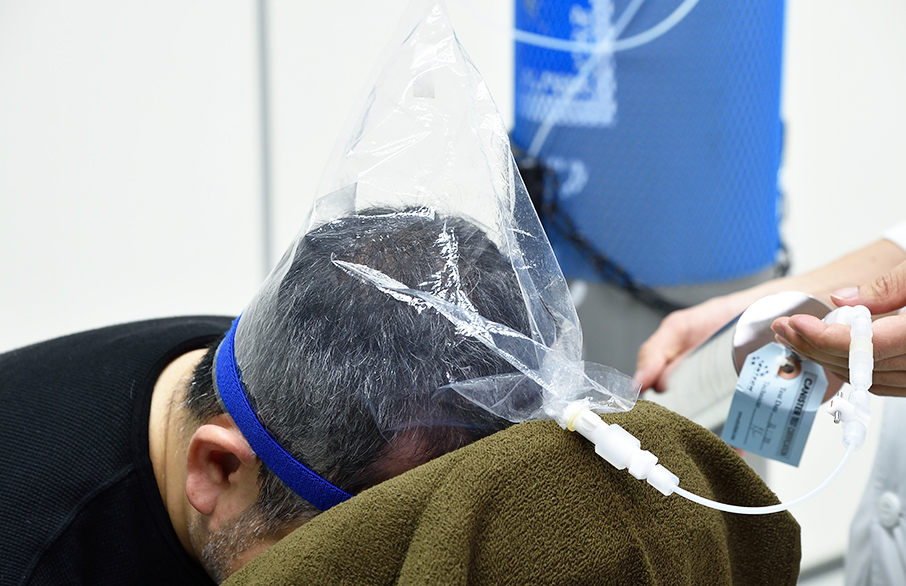
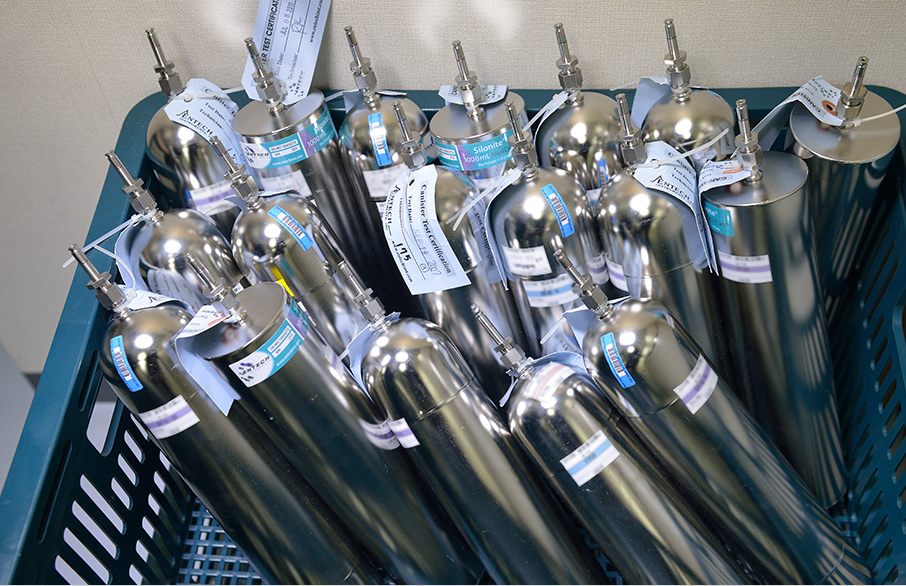
Used odor measuring device "GC-MS-O" to identify body odor molecules
After gathering a large amount of samples, we measured and analyzed the compounds of the odor.
Although we refer to it as "odor," the smell is actually comprised of various volatile compounds, so we need to identify the specific compounds involved in body odor.
This is where the "GC-MS-O" comes in. Odors that are comprised of multiple components are separated instrumentally, after which trained experts smell the individually separated components here, for analysis.
After using this device to separate odor compound individually, we identify each molecule and used our noses to smell the odor emitted from the exhaust port to check the smell.
Then we identified the compounds of the odor by comparing information we gained on the structure of odor compounds versus information on the strength of odors we gained from using our actual noses.
Thanks to this research method, we discovered the compound that causes middle-aged oily odor.
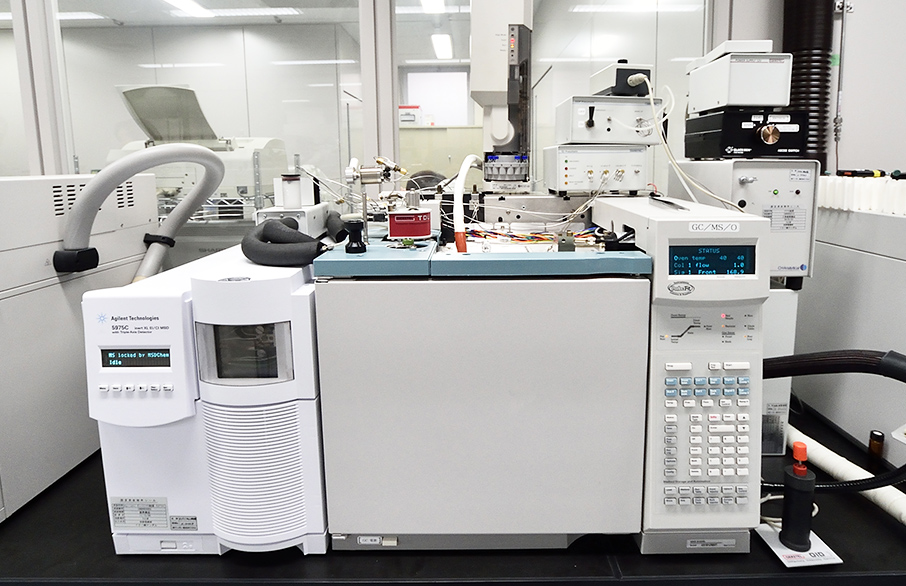
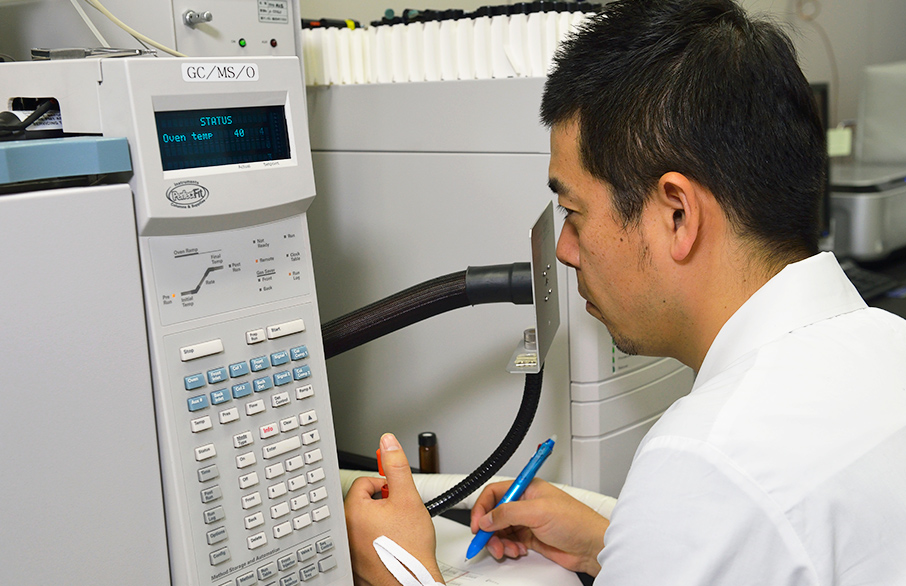
"Diacetyl" is a key compound
that causes middle-aged oily odor

We discovered that "diacetyl" was the true culprit behind middle-aged oily odor.
After examining the relation between how much this compound is produced on men's heads versus test subjects' age, we discovered that it was mainly 40-year-old men who produced the most diacetyl, and men between the ages of 20 and 40 tended to produce more diacetyl as they grew older. (Figure 3)
This tendency coincides with the age range when consumers notice a change in their body odor, and demonstrates that the increased production of diacetyl on men's heads is the compound causing the peculiar body odor found in middle-aged men.
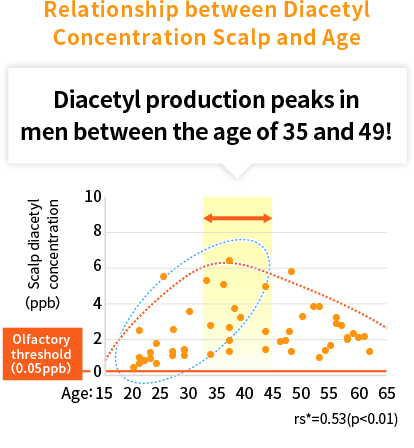
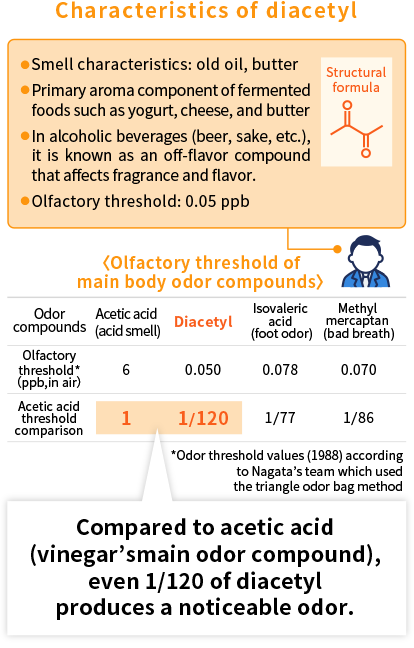
Mandom starts developing
technology
that
suppresses diacetyl

Discovering the mechanism that produces diacetyl
How is diacetyl produced?
In order to develop technology that effectively suppresses the production of diacetyl, Mandom first identified the compounds in sweat and the skin bacteria that cause diacetyl to be produced on the skin. (Figure 5/6)
Afterwards, the company analyzed the mechanisms that produced diacetyl through a mixed culture of skin bacteria and metabolites in sweat. As a result, Mandom discovered that Staphylococcus epidermidis and Staphylococcus aureus (main bacteria found on the skin) metabolized lactic acid in sweat, and after undergoing a process that changed it to pyruvate and acetoin, the final result was diacetyl that emitted an offensive odor. (Figure 7)
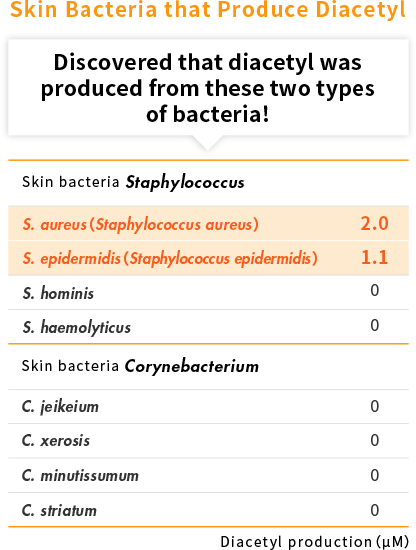
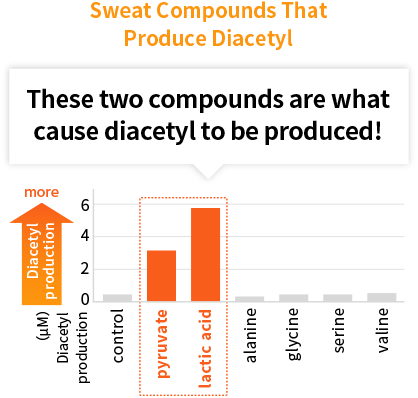
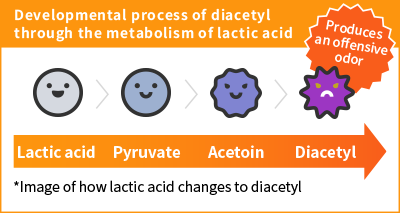

Flavonoid-containing plant extracts contain suppressive effect
Complete survey of 102 different types of plant extracts
Next, the company searched for materials that effectively suppress diacetyl.
Mandom's research team evaluated the suppressive effects 102 types of plant extracts had on diacetyl.
As a result, the team discovered that several plant extracts containing flavonoids such as licorice and cinnamon effectively suppressed diacetyl produced by skin bacteria.
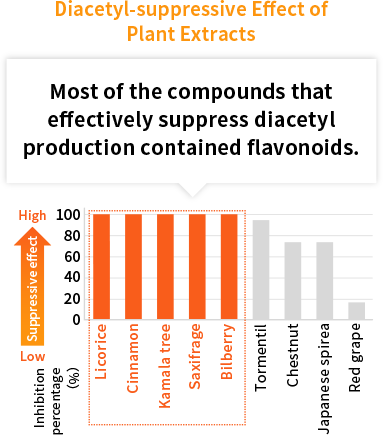
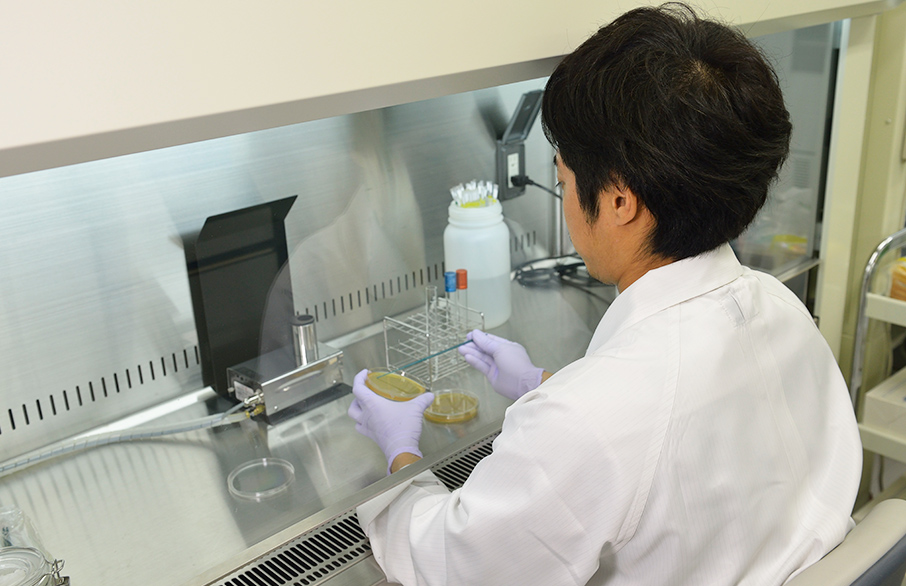


Furthermore, after confirming how these plant extracts function in the process of diacetyl production, the team discovered that the plant extracts reduce the speed at which lactic acid is metabolized into pyruvate and limit its uptake into bacterial cells. (Figure 9-1, 9-2)



From these results, Mandom found that the flavonoid-containing plant extracts' suppressive effects towards the production of diacetyl were due to the suppressed metabolism of lactic acid to pyruvate.
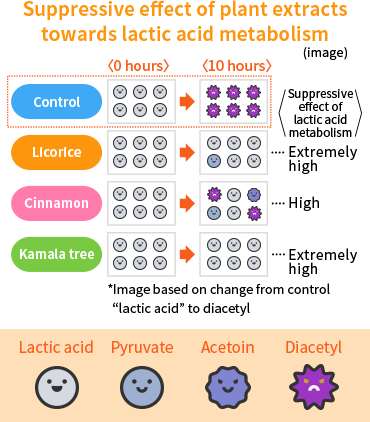
The search for measures
against "middle-aged
oily odor" continues
Thanks to the results of this research, we discovered the truth about the peculiar body odor of middle-aged men that had eluded us until now.
We identified the existence of a third odor called "middle-aged oily odor" which falls in line with the two odors we already knew existed, namely "sweaty odor (axillary odor)" which is mainly found in the armpits, and "aging body odor" which is prominently found mainly in men aged 50 and above. These discoveries allowed us to gain and accurate understanding of body odors that changed depending on the consumers' age and region, and enabled us to come up with suitable and effective body odor care solutions.
Mandom will continue placing efforts into its research on "middle-aged oily odor" as part of is major research theme.

Sensory evaluation of the head
- Time of
Examination - July-August 2009
- Test Subjects
- 26 healthy Japanese men (number of men in their 20s: 16, number of men in their 40s and 50s: 10)
- Evaluated
Items - Odor strength (6 levels) & odor type (8 types)
- Evaluators
- 4 Mandom researchers (including Olfactory Measurement Operators)
- Evaluated
Regions -
- 4 regions on the head (24 hours after being cleaned)
- Pillow cover (after 1 week of use)